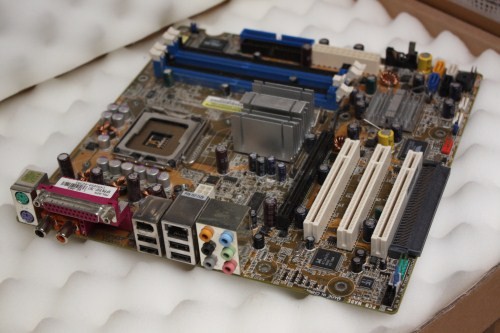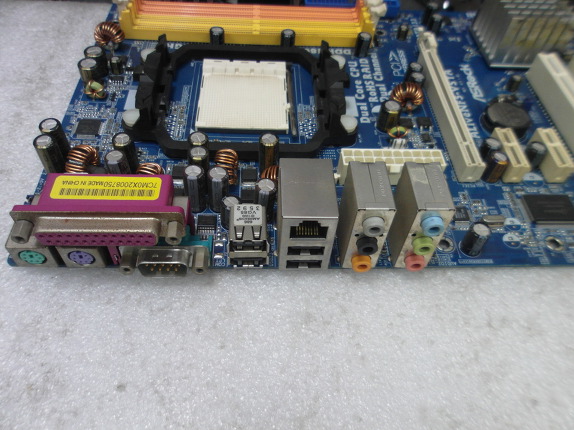
Asus Ptgd1 La Bios Update
Sepanjang masa kpm. Once you place an order, you (or someone you know) can pick it up at a Kmart store, have it shipped or delivered to a U.S. You can pay for your order in a store or even use an international credit card.
HP Pavillion a820n Desktop ASUS PTGD1-LA AMI Bios. Do the job, Intel GMA 915 driver for Aero is in the upgrade under Optionnal update.
Archived from groups: alt.comp.periphs.mainboard.asus () In article, billiebobt wrote: > Anybody know where to find these, looked all over the Asus site > without success. Thanks for ant help When HP uses a board, the version is custom made for HP. In some cases, when Asus makes one of these OEM boards, they make a virtually identical version for retail as well. Those are the cases where messing around would be the most productive. Looking through the current Asus list of products, I don't see anything that matches the picture here.
Your board is a microATX PCI-Express video board, but with no PCI-E x1 slots, only the x16 for the video card: Let us say you grab the BIOS for a 915 board that uses DDR memory. You somehow manage to bypass the flasher check for the Asus product string. You flash in the Asus BIOS. If you were to do that, you might find some of the onboard peripherals (LAN, firewire) might stop working (as the new BIOS doesn't know how to enumerate them). If the motherboards differ in the definition of any special purpose GPIO signals (which are used to turn stuff on and off), there is no way of knowing what will happen.
At the very least, if you want to turn your motherboard into a guinea pig, buy a BIOS Savior from ioss.com.tw (about $25), as that device gives you dual BIOS chips. You can then do as many experiments as you wish using one BIOS chip, and if any of the experiments fails, you simply flip the switch on the BIOS Savior, and run the original HP BIOS again. Yes, people have done the kind of brain surgery you are proposing before, but it helps a lot if the motherboards bear some resemblance to one another, from an architecture and implementation standpoint. Flashing the BIOS is not an insurmountable problem, but will be a challenge nonetheless. (For example, you could purchase a preprogrammed BIOS chip from badflash.com, but what BIOS image do you use to do the job? If you are going to try this route, you will also need to make sure the size of the BIOS chip on the HP board is the same as the size of the BIOS image coming from the Asus board. An OEM board is likely to use a smaller flash chip than a regular Asus board, because that reduces the manufacturing cost by a bit, which makes the brain surgery yet more complicated.
With LPC flash chips, this is probably not a big deal, and just requires that the flash chips used are big enough to hold either an Asus or an HP image.) If you want to see a datasheet for a flash chip, look at page 16 of this document. This product comes in several sizes, but this datasheet only shows two of them and how they differ in operation: (from HTH, Paul. Archived from groups: alt.comp.periphs.mainboard.asus () nospam@needed.com (Paul) wrote: >In article, billiebobt wrote: > >> Anybody know where to find these, looked all over the Asus site >> without success. Thanks for ant help > >When HP uses a board, the version is custom made for HP.
> >In some cases, when Asus makes one of these OEM boards, they >make a virtually identical version for retail as well. Those >are the cases where messing around would be the most productive. > >Looking through the current Asus list of products, I don't see >anything that matches the picture here. Your board is a microATX >PCI-Express video board, but with no PCI-E x1 slots, only the >x16 for the video card: > >> >Let us say you grab the BIOS for a 915 board that uses DDR >memory. You somehow manage to bypass the flasher check for >the Asus product string.

You flash in the Asus BIOS. > >If you were to do that, you might find some of the onboard >peripherals (LAN, firewire) might stop working (as the new >BIOS doesn't know how to enumerate them). If the motherboards >differ in the definition of any special purpose GPIO signals >(which are used to turn stuff on and off), there is no way >of knowing what will happen. > >At the very least, if you want to turn your motherboard into >a guinea pig, buy a BIOS Savior from ioss.com.tw (about $25), >as that device gives you dual BIOS chips. You can then do >as many experiments as you wish using one BIOS chip, and if >any of the experiments fails, you simply flip the switch on >the BIOS Savior, and run the original HP BIOS again. > >Yes, people have done the kind of brain surgery you are >proposing before, but it helps a lot if the motherboards >bear some resemblance to one another, from an architecture >and implementation standpoint.